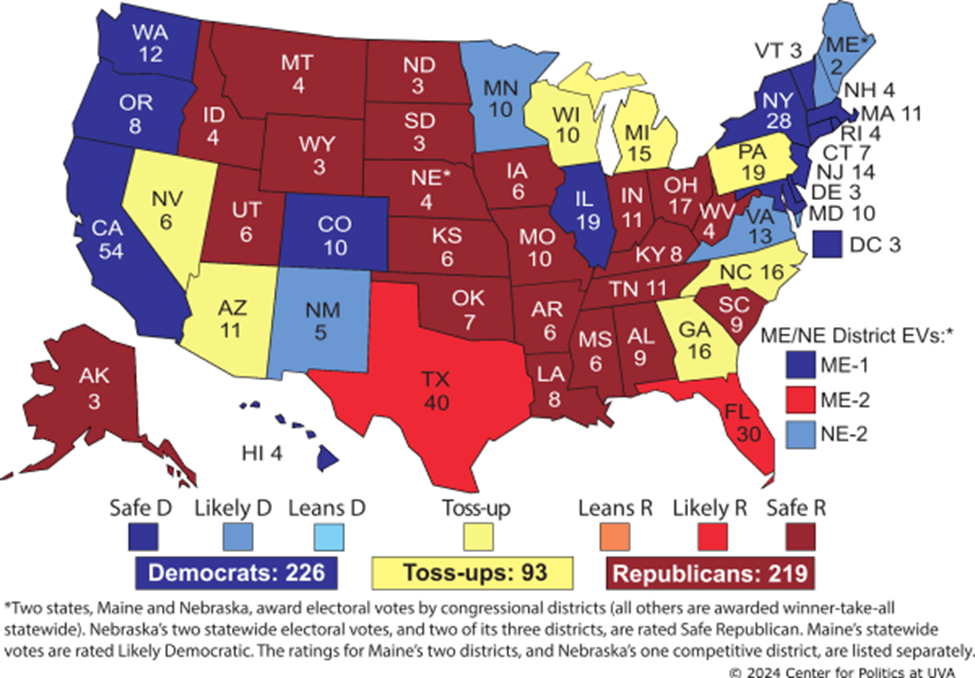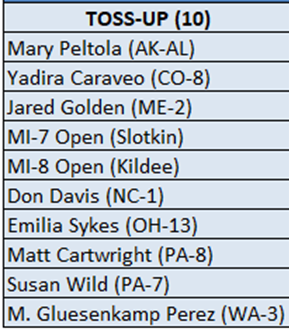Your inside look at Election Day
Presidential Election
With less than a month until Election Day, the race for the White House and control of Congress remains tight. Prior to President Biden’s decision to withdraw from the race, former President Trump had a lead in most national and swing state polls. With her entry into the race, Vice President Harris narrowed President Trump’s lead and even made more states, like Georgia and North Carolina, competitive. Most prognosticators rate only seven states (in yellow below) as true toss-ups. These seven states account for 93 electoral votes.
According to most polls, Democrats can rely on 226 electoral votes while Republicans have 219. This means Vice President Harris needs 44 electoral votes to win, while President Trump needs 51. While polls in these swing states show a close race, Vice President Harris maintains leads in Nevada, Pennsylvania, Michigan, and Wisconsin. Factor in virtual dead heats in Arizona, Georgia, and North Carolina, Vice President Harris looks to have the most avenues to 270 electoral votes. However, with poll after poll showing a tight race, the outcome is far from set.

Senate Races
The battle for the Senate has shifted in favor of Republicans in recent weeks. The Democrats hold only a slight 51-49 seat majority and face a difficult map by having to defend several seats in battleground states and states President Trump won in 2020. With the retirement of Sen. Joe Manchin (I-WV), an independent who caucuses with the Democrats, Republicans are all but assured of flipping West Virginia. Sens. Jon Tester (D-MT) and Sherrod Brown (D-OH) are the next most vulnerable Democrats. Both Montana and Ohio are states President Trump won handily in 2020. With Ohio the last remaining “Toss Up” race, Sen. Brown seems to be in a strong position to be re-elected. On the other side of the country, polls in Montana indicate a shift in favor of Republican challenger Tim Sheehy. Combined with West Virginia, a Republican win in either Ohio or Montana would give Republicans 51 seats and a majority in the Senate. Elsewhere in the country, polls in Wisconsin, Michigan, Pennsylvania, and Nevada show tight races in favor of Democrats.

House Races
With only a four-vote majority and limited legislative achievements to run on, Republicans face an uphill climb to retain their majority in the House. Election rating show a total of 206 seats as either Safe, Likely, or Lean Democratic and a total of 211 seats as either Safe, Likely, or Lean Republican. This means only 18 “Toss Ups” seats will decide the outcome of the election. Half of the Republican-held toss ups are in Southern California while most of the Democratic-held toss ups are scattered throughout the Midwest. Despite having fewer seats in the Safe, Likely, and Lean column and defending more “Toss Up” rated seats, election forecasts predict Democrats will claim the majority in the House. Like the Presidential and Senate races, polls in these House races are very close and the final outcome could still go either way.


